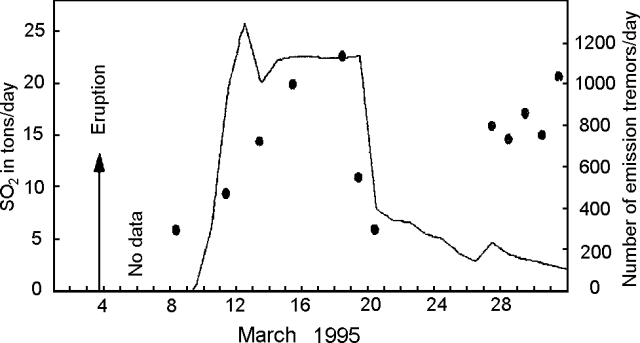Report on Tengger Caldera (Indonesia) — March 1995
Bulletin of the Global Volcanism Network, vol. 20, no. 3 (March 1995)
Managing Editor: Richard Wunderman.
Tengger Caldera (Indonesia) Eruption at Bromo causes ashfall 20 km away; gas emissions
Please cite this report as:
Global Volcanism Program, 1995. Report on Tengger Caldera (Indonesia) (Wunderman, R., ed.). Bulletin of the Global Volcanism Network, 20:3. Smithsonian Institution. https://doi.org/10.5479/si.GVP.BGVN199503-263310
Tengger Caldera
Indonesia
7.942°S, 112.95°E; summit elev. 2329 m
All times are local (unless otherwise noted)
An ash eruption from the active vent on the N side of Bromo crater at 0600 on 3 March produced a dark gray plume that rose 100-200 m above the crater rim. The plume extended >20 km S and SE, causing ashfall (0.5-2 mm thick) that covered ~10 km2 of cultivated land in and around the area of Sukapura (~20 km away). No injuries were reported as a result of this activity. Continuous weak-to-moderate gas emissions lasted through the end of March. COSPEC measurements showed that the SO2 flux was 6 t/d on 8 March. SO2 emission gradually increased to a peak of 22.8 t/d on the 18th before dropping again on 19-20 March (figure 1). Measurements during 27-31 March were again higher, 15-21 t/d.
 |
Figure 1. SO2 values measured by COSPEC (dots) and daily number of gas-emission tremor events (solid line) at Bromo (Tengger Caldera), March 1995. Courtesy of VSI. |
Volcanic tremor events associated with the gas emissions (maximum amplitude 2-7 mm) were recorded continuously beginning on 9 March using PS-2 and Teledyne seismographs installed between 500 and 1,000 m from the active crater. The number of distinct earthquakes (maximum amplitude1,100 to ~400, and gradually decreased through the end of the month (figure 1). Three tectonic earthquakes were detected on 23 February, and one each on 24 and 28 February, and 28 March.
Geological Summary. The 16-km-wide Tengger caldera is located at the northern end of a volcanic massif extending from Semeru volcano. The massive volcanic complex dates back to about 820,000 years ago and consists of five overlapping stratovolcanoes, each truncated by a caldera. Lava domes, pyroclastic cones, and a maar occupy the flanks of the massif. The Ngadisari caldera at the NE end of the complex formed about 150,000 years ago and is now drained through the Sapikerep valley. The most recent of the calderas is the 9 x 10 km wide Sandsea caldera at the SW end of the complex, which formed incrementally during the late Pleistocene and early Holocene. An overlapping cluster of post-caldera cones was constructed on the floor of the Sandsea caldera within the past several thousand years. The youngest of these is Bromo, one of Java's most active and most frequently visited volcanoes.
Information Contacts: W. Tjetjep, VSI.

